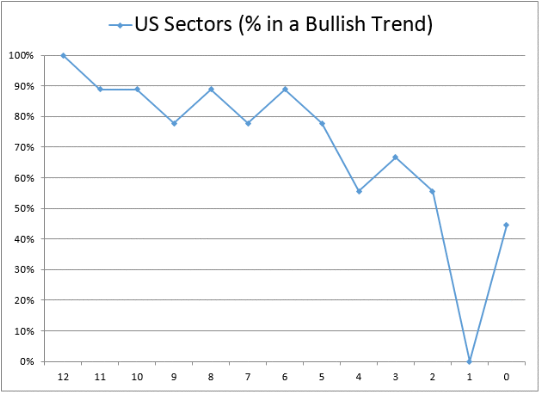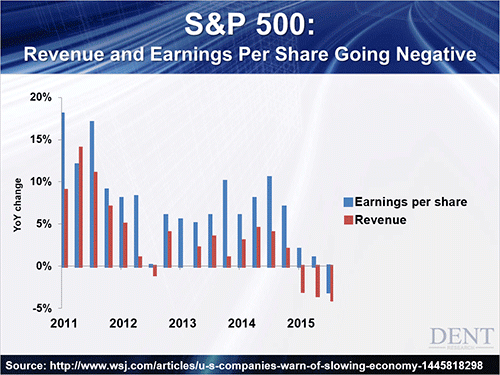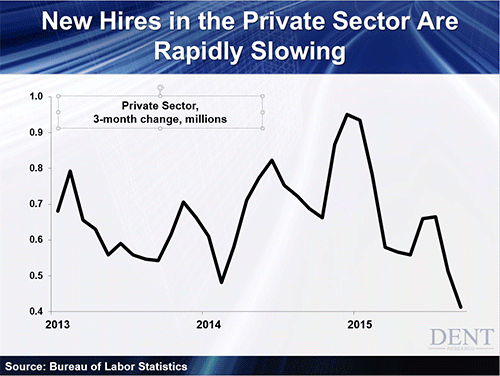Harry S. Dent Jr.'s Blog, page 129
November 9, 2015
A Little Secret of the Financial Planning Industry
 Here’s a dirty little secret of the financial planning industry: most financial planning rules are so dumbed down you can’t even use them.
Here’s a dirty little secret of the financial planning industry: most financial planning rules are so dumbed down you can’t even use them.
In fact, I would argue they’re downright harmful, and following them might very well cost you your retirement.
Let’s start with perhaps the biggest offender of all: the rule that says your allocation to stocks should equal 100 minus your age. The rest, you should put toward cash and bonds.
Forget it.
It’s a terrible rule that completely ignores the fundamentals of investing.
This rule doesn’t so much as consider how relatively cheap or expensive stocks and bonds are.
That’s just basic common sense!
And never mind the fact that there is a broad world of investments completely outside the stock and bond markets.
There’s real estate… options strategies… commodity trading funds…and a whole list of alternatives.
The smart money that manages the Harvard and Yale endowment funds heavily favors alternative investments. Why shouldn’t we follow their lead?
Then there’s this one: the 4% Rule.
The idea here is that 4% is the highest “safe” withdrawal rate that will survive a 30-year retirement without depleting your portfolio.
Under the rule, which became standard planning practice in the 1990s, you take a 4% withdrawal in the first year of retirement and adjust the figure up by the rate of inflation.
There’s one major problem here. The model assumed a 50/50 or 60/40 mix of stocks and bonds, and bond yields were a lot higher in the 1990s.
At current prices, bonds aren’t going to generate enough income to meet the 4% rule. And given that stocks are very expensive right now, that’s a risky move to rely on as well.
So, what’s an investor to do?
To start, you should have an open mind when it comes to choosing asset classes. If traditional assets classes like stocks and bonds are not attractive – welcome to today! – you’ve got to look elsewhere.
It also pays to be flexible in concern to income.
When it comes to paying your bills in retirement, it doesn’t really matter where that dollar comes from. It can be an “income” dollar paid via dividends or interest, or a “capital gains” dollar generated from trading or growth strategies.
Your decision here will have a lot to do with what the market is offering. If you can’t realistically pay your bills given the yields in safe income investments, then creating “synthetic dividends” by trading stocks and options might be your only option.
As a general rule, I prefer to use income dollars for personal expenses to avoid selling shares. If you’re looking to sell long-term, buy-and-hold investments, you can really get yourself into a mess.
And in a prolonged bear market, selling your shares can be akin to a farmer eating his seed capital. Shares sold at depressed prices are shares that won’t grow in value when the market turns around.
But this doesn’t mean I buy overpriced income securities just for the income, either.
In the end, you should invest where you believe you can earn the best return. And if that means a larger allocation than usual to shorter-term trading strategies, so be it.

Charles Sizemore
Editor, Dent 401k Advisor

November 6, 2015
This Is One of the Greatest Deceptions of Our Time
CRISPR: The Next Step Forward in Eradicating Congenital Diseases
November 5, 2015
Don’t Become A Boiled Frog
 I recently explained why many investors become “boiled frogs.”
I recently explained why many investors become “boiled frogs.”
Namely, they focus on the S&P 500 index rather than its individual components.
They’re also slow to prepare for a down market. They wait until the market has already lost 20%, the official definition of a bear market, before trimming down their exposure. By then, it’s already too late.
So today, let’s talk about a better way…
It starts with a simple concept: adaptation is the key to surviving change. I learned the intimate details of this truth as a biology major in college. But even non-science types should be familiar with this idea thanks to Charles Darwin’s quote: “
It’s not the strongest species that survives, nor the most intelligent. It’s the one that is most adaptable to change.”
Politicians get criticized for changing their opinion on a topic, as if conviction in one’s beliefs is more important than anything else. But scientists are required – by the ethics of their profession – to change their minds, theories and research actions when new information comes along. Even if it makes them look like a “flip-flopper.”
Naturally, as an analyst, I side with the modus operandi of the scientists.
After all, the stock market doesn’t pay anyone for their opinions or convictions. It only pays investors for being on the right side of the prevailing trend. And because that trend is constantly changing, investors must adapt constantly or else go the way of the dodo.
So when I designed Cycle 9 Alert three years ago, I made certain it would be able to adapt to a variety of (constantly changing) market conditions – bullish, bearish and all the shades of grey in between.
At the time, I realized I had two options for ensuring my service could play both sides of the market. One was an “All or Nothing” approach. This would have involved a simple rule like this:
If the S&P 500 index is in a bull market, consider only bullish positions.
If the S&P 500 index is in a bear market, consider only bearish positions.
This approach has the advantage of being clear and simple. But it’s imprecise and unable to adapt quickly and efficiently.
This is where we find the frogs slowly boiling in water. You see, the stock market doesn’t flip from a bull market to a bear market in an instant. Instead, the process is agonizingly slow. And the change comes about in a slippery way – so it’s difficult to detect it’s happening, until after it’s already happened. It’s why the frog doesn’t jump from the pot… and why many investors hold hemorrhaging stock portfolios for far too long.
This chart proves my point…

Here, I’ve plotted what percentage of the nine U.S. stock sectors were in a bullish trend over each of the last 12 months.
Twelve months ago… all nine sectors were bullish.
Ten months ago… eight out of nine were bullish.
Five months ago… seven out of nine were bullish.
Four months ago… only five out of nine sectors were holding a bullish trend.
And then, a month ago… all nine sectors were in a bearish trend!
That’s what a pot of slow-boiling water looks like. And that’s why I engineered Cycle 9 Alert to have a more advanced adaptation mechanism – rather than a rudimentary “on/off” switch based on an aggregate stock index, or an arbitrary definition of a bear market.
At the risk of mixing analogies, Cycle 9 Alert’s adaptation mechanism works much like a mountain bike.
Mountain bikes don’t have just two gears – one for flat terrain, and one for steep inclines. Although that bike would work just fine for me here in Florida, where a single-speed beach cruiser does the trick, I certainly wouldn’t take it to the Colorado ranch that my wife and I visited last year. The mountains were insane!
Most mountain bikes have between 21 and 27 gears. This gives the rider much more flexibility – to quickly and efficiently adapt to subtle changes in terrain and incline. Instead of simply gearing the bike for either “flat” or “mountain” terrain, the rider can better adapt to all shades of grey in between.
Cycle 9 works much the same. We aren’t limited to just two “gears” – 100% bullish or 100% bearish.
That’s because, instead of applying my trend-following rules to an aggregate stock market index (i.e. the S&P 500), I apply them individually, to individual sectors and stocks. This looks like:
If is in a bullish trend, consider a bullish position.
If is in a bearish trend, consider a bearish position.
This construction gives us unlimited access to the market’s shades of grey – when it’s neither 100% bullish, nor 100% bearish. And it allows us to gradually adjust our positioning since, as the chart above shows, market conditions change gradually, not instantaneously.
To good profits,

Adam O’Dell, CMT
Chief Investment Strategist, Dent Research

2016: The Scene Is Set
 A good rule of thumb to live by is to believe nothing you’re told and only half of what you see with your own eyes. That might sound cynical, but it’s kept me out of trouble more than once.
A good rule of thumb to live by is to believe nothing you’re told and only half of what you see with your own eyes. That might sound cynical, but it’s kept me out of trouble more than once.
This is particularly relevant today when considering inflation. We’re constantly told there isn’t any inflation or it’s so low the Federal Reserve could not possibly raise interest rates.
What a load of bunk!
For those of us who live in the real world, we know this is bogus. We’re getting our clocks cleaned by higher prices and stagnant wages. And Social Security recipients are being outright cheated with their 0% inflation increase for next year.
Gas prices are down, but food prices are through the roof! (That’s why one of our recent short targets in Forensic Investor is a food producer. It’s seen prices skyrocket but its profitability dwindles by out-of-control costs.)
Tuition costs are skyrocketing! The College Board projects that by 2033 it will cost almost $324,000 to attend a private university. How is that even remotely justifiable… or affordable for that matter?
Health care costs are out of control! And I’ve felt the sting of this recently (I know Rodney has as well, because he’s complained about this lately too)…
The other day I opened my mail to see that my health insurance coverage will remain intact. It will, but I was none-too-pleased to see that my premium is going up by 24.33%! That’s crazy. Fortunately, I’m healthy and have negligible doctor bills. Unfortunately, that means I’m paying 24% more for coverage I’ll likely not even use.
You’ll agree with me on this: money doesn’t grow on trees. My health care bill has gone from being a relatively minor expense two years ago to the largest monthly cash outlay in my business.
Something has to give. And that’s not good for the economy.
Seventy percent of the U.S. economy is consumption based. When no one has any money left to buy anything, it’s going to eventually filter its way through the economy. And I’m afraid we’re already seeing the effects. Corporate revenues and earnings are getting pinched hard this quarter. This trend will continue.
2016 is setting itself up to be a year to remember… and not in a good way. Look to preserve capital wherever possible. Then, grow that capital with strategies like the one I use in Forensic Investor.
Best,

John Del Vecchio
Editor, Forensic Investor

November 4, 2015
Caution: Speed Bump Ahead
 I went to college in the 1980s. Even though the decade was market by a lust for cash, which led to lavish lifestyles, big hair, and the cocaine wars, one of the television heroes of the day was usually broke.
I went to college in the 1980s. Even though the decade was market by a lust for cash, which led to lavish lifestyles, big hair, and the cocaine wars, one of the television heroes of the day was usually broke.
Thomas Magnum (Tom Selleck), was a private investigator and beach bum. While he personally didn’t own any toys of the rich and famous, he was a permanent guest of the fabulously wealthy Robin Masters. As such, Magnum had access to everything, including the coolest car of the day – a red Ferrari 308 GTS.
Because of the popularity of the show, that car is one of the most recognizable vehicles in history, and it still turns the head of every guy near my age. (For a bit of trivia on that car, read the P.S.)
The world appetite for Ferraris has waxed and waned over the years, but the boost the company received from that show never faded. The car remains a singular status symbol.
Recently the company went public, cashing in on its fame. Unfortunately for investors who bought the shares…
…the offering came right as the biggest potential market is turning down. Coupled with another development, this clouds Ferrari’s future, but it bodes well for another iconic product.
There’s no question that the Chinese economy is slowing. Last quarter, GDP growth fell below 7% for the first time since the financial crisis. Unlike back then, there’s no crisis today. Instead, world demand is simply trailing off without any expectation of a quick bounce back.
Chinese exports fell 9% in July, and 5.5% in August. That’s tough. But what’s more telling is that imports were off more than 13% in August, pointing to a slowdown in both the manufacturing of exports and domestic demand. Unfortunately for businessmen and government officials, financial pressure isn’t the only problem they face.
Chinese President Xi Jinping made rooting out corruption a top goal of his tenure. He has removed several top party officials from their posts and put them on trial, which is just a formality. I’ve yet to hear of any Chinese official charged with corruption who emerged victorious from the court system. To avoid unwanted scrutiny from regulators, people of all stripes are avoiding flashy displays of wealth, like Ferraris.
The double whammy of a falling economy and more cautious wealthy consumers created a shortfall in the car company’s Asian sales. Overall, third-quarter sales beat estimates. Revenue increased 9% and profit popped 62%. But sales in Greater China fell by 50 units, or 24% from the previous quarter.
The company only sold 1,949 units around the world, so a 50-unit shortfall should give it pause, especially since it occurred in the region that’s supposed to account for much of the growth in the years ahead.
Apparently investors are worried about the speed bump. After earnings were announced, Ferrari’s share price fell well below the recent IPO price. The stock then recovered some of its lost ground, but it’s definitely not winning any races.
The story couldn’t be more different for another iconic product that also recently announced earnings.
While sales of its iPhone 6 and iPad both fell slightly shy of expectations, Apple posted a $50.9 billion increase in revenue over the last 12 months, with a whopping $26.9 billion coming from China. The country accounted for 39% of Apple’s sales growth in 2014, 57% in the first quarter of this year, and 66% in the most recent quarter. The strongest numbers were in iPhone sales.
There’s no doubt that cheaper phones are available. They all make phone calls, and many of them provide texting platforms and the ability to surf the Internet. But the competitors aren’t iPhones, which are definitely the Ferraris of mobile communication.
What makes the iPhone different from a Ferrari is that it costs less than $1,000 and fits in your pocket. They still might be a status symbol, but not on a scale quite as grand, which will be Ferrari’s problem for years to come.
Consumers prioritize their spending. When money gets tight, or circumstances become more difficult, they might not be able to “go big” in quite the way they did before. But they can still splurge in small ways. This explains why life in China is looking up for Apple, but could be a hard road for Ferrari.
Consider this when deciding where to put your investment dollars.
Rodney
Follow me on Twitter @RJHSDent
P.S. Here’s some 308 GTS trivia for you: the producers originally wanted to use a Porsche 928, but Porsche wouldn’t make the sunroof bigger (bet they’re sorry now), so they chose the Ferrari with the Targa top. However, the car was too small for the 6’4” Selleck, so they took the padding out of the driver’s seat and bolted it to the floor as far back as it would go. Even with the modifications, he was rarely filmed with the top on the car. Also, they used four different year models, all 308 GTSs, while filming the series. Because of the popularity of the car, the model still costs around $35,000, and parts are said to be breathtakingly expensive.

Whipsaw, Or Whiplash?
 After sucking wind in August and September, stocks rallied an epic 8% in October.
After sucking wind in August and September, stocks rallied an epic 8% in October.
There’s a term for this seemingly odd experience. It’s called a whipsaw, which basically describes when something alternates rapidly in contrasting directions.
In market-speak, a whipsaw is when the dominant trend turns from bullish to bearish (as it did in August/September)… and then, very quickly, back to bullish (as it did in October).
The sudden reversals leave adaptive strategies (i.e. those that adjust, long and short, depending on the trend) temporarily on the wrong side of the trend. It’s certainly an unpleasant experience, but it’s largely an unavoidable “cost of doing business” as a trend-following investor.
Interestingly though, many of these bullish-to-bearish-to-bullish whipsaws have occurred before significant declines.
In 2001, after the trend turned from bullish to bearish, stocks rallied 20% in 32 days… then stocks fell 29% over the next four months.
In 2007, after the trend turned bearish, stocks rallied 12% in 40 days… then they fell 23% over the next three months.
In 2008, after the tide turned bearish again, stocks rallied 15% in 44 days… then they plummeted 60% over the next nine months.
History shows that it pays to stay bearish throughout these whipsaws, bearing the pain of the short-lived rallies, which have typically lasted between one-and-a-half and two months.
Of course, there are also historical examples that show a different pattern – one in which bullish trends prevail. I shared the details of these with my Cycle 9 Alert subscribers yesterday.
My point is that a sharp, one- to two-month rally, following a newly-emerged bearish trend, is common.
So even though bearish stock positions have taken heat over the last five or so weeks, there’s still a good chance the rally will peter out and be followed by a tumble. That’s why, for now, we’re staying in well-positioned bearish and hedge plays only in our Boom & Bust portfolio.
Best,

Adam O’Dell, CMT
Chief Investment Strategist, Dent Research

November 3, 2015
It Sure Beats Cable
 I subscribe to Netflix, and I use it once a week. Typically my wife and I will watch an episode of Blacklist, followed by Longmire. For Blacklist, we’re just getting through the second season, which is all that’s available on Netflix so far. As for Longmire, we’re watching new episodes.
I subscribe to Netflix, and I use it once a week. Typically my wife and I will watch an episode of Blacklist, followed by Longmire. For Blacklist, we’re just getting through the second season, which is all that’s available on Netflix so far. As for Longmire, we’re watching new episodes.
What makes this interesting is not our viewing habits, but the fact that new episodes of Longmire exist.
The cable company that originally put the show on the air cancelled it. Netflix scooped up the rights to it, produced new episodes, and instantly had viewers like me.
Clearly the company can make a profit where the cable company couldn’t. In this sense, Netflix is disrupting the media business just as Apple did with the iPod and iTunes. They are building a business off of the long tail. Instead of offering a small number of products that do exceptionally well, they offer a multitude of products, which together get enough views to make the business successful in a way cable companies aren’t.
As a point of disclosure, I currently own Netflix in my Triple Play Strategy. It was rocky for a bit there, but there’s no question that the company clearly fits one of my main criteria. It falls into the category of what people will do in the months and years ahead.
Without getting deep into high school statistics, the long tail refers to data points that occur far away from the average.
How many Longmire viewers must Netflix have for the series to be profitable? I don’t know, but because they simply stream the service, and can put all episodes up at once, they can make money with a lot fewer viewers than cable! This allows the company to offer many more shows, which draws a wide audience of viewers who can seek out the content they want.
Think about the lack of competition for airtime.
On cable, there’s just one slot open every Tuesday night at 8:00 p.m. If the show in that slot isn’t drawing viewers, it must be replaced.
On Netflix, if a show happens to draw fewer viewers, that’s OK. It didn’t displace any other show to be there!
The company is also pushing into new territory. It just released its first feature-length film, Beast of No Nation. Interestingly, Netflix didn’t make the film. It was made by an independent group for about $6 million, and Netflix bought the distribution rights.
Because of the subject matter, large studios didn’t think it would draw big theater audiences, even though it’s considered a contender for an Oscar Award, so they passed.
They were right. Netflix released the film in 31 theaters as well as online. To be considered for an Oscar, it had to be released in theaters. The film earned a mere $1,635 per theater on opening day, which is abysmal.
Well, it is if you’re a major studio relying on ticket sales at theaters.
If you’re Netflix, then it really doesn’t matter. The film received fabulous reviews, which means that the streaming company’s 60-plus million subscribers are more likely to hear about it and click on it. If it wins an Oscar, then the buzz will only grow louder!
This is exactly what happened with digital music, the iPod, and independent (or “indie”) bands.
Instead of requiring a recording studio to sign a band, cut a record, and hope for some coveted radio airtime, indie bands could record their music and then make it available through iTunes. If the bands were discovered by listeners, then their music would go viral without the limitations and hassles of radio airtime.
So as Netflix slides down the long tail of video content, subscribers are the real winners. We get access to shows and movies that would never have been made or offered without such a distribution platform. Sure, big studios and cable companies might suffer. But independent film makers and small production groups must be jumping for joy.
But none of this means that Netflix shies away from well-known names.
The company will debut the sequel to Crouching Tiger, Hidden Dragon in the first part of 2016, and is currently in talks to roll out the next installment of Star Wars. Netflix inked a deal with Disney for exclusive rights to all offerings created by Disney after January 1, 2016. The new Star Wars rolls out December 18, so its future on Netflix is up in the air.
So the next time you sign on to Netflix, know that you’re part of the digital nation. You’re helping the company break the chains of cable and offer a platform to independent producers… even if you choose to watch nothing but your old favorites.
Rodney
Follow me on Twitter @RJHSDent

All Talk and No Action
 For whatever reason, the world seems to hold its breath whenever the Fed meets, speaks or acts. Last week’s meeting was no exception. Quantitative easing (QE) was halted a year ago, but we’re still at an effective zero interest rate today.
For whatever reason, the world seems to hold its breath whenever the Fed meets, speaks or acts. Last week’s meeting was no exception. Quantitative easing (QE) was halted a year ago, but we’re still at an effective zero interest rate today.
The Fed says consumers are spending more and our unemployment rate is low. But aside from iPhones and health care, I’m not sure what people are spending their money on with zero wage growth.
New home sales have been on the rise but are still only a fraction of what they were before house prices started to melt down in 2005. And new homes sold for under $200,000 were at a record low for the month of September. The median new home price has risen to near $300,000, which is near a record high.
Of course, houses are an “asset” rather than an “expense” and not included in the Fed’s inflation calculations.
The Fed is still worried about deflation, but aside from falling energy prices, it’s hard to see what they’re worried about. Housing costs have skyrocketed, health care costs are quickly on the rise, and if you have kids in college you know education costs are going up sharply.
The Fed credits themselves for saving the world when we were on the brink of financial meltdown in 2008. Since Congress is and has been unable to be fiscally responsible for decades, the Fed is charged with not only stabilizing prices for goods and services but to also allow for maximum employment.
But while quantitative easing (QE) helped create a rising stock market, it did little to encourage companies to invest more capital, grow revenues or hire more workers. It also encouraged to borrow more and buy back their own stock to help juice their earnings.
So here we are, a year after the end of QE and the stock market is near all-time highs, short term interest rates are still yielding zero percent, wage growth is still non-existent and inflation is still below the Fed’s 2% target.
The Fed has been talking about normalizing rates, but hasn’t been able to do so because the economy is not cooperating. Their policy decisions have failed. They’re stuck.
What will they do in December? Probably talk about raising rates sometime in the future.

Lance Gaitan
Editor, Dent Digest Trader

2016: What Analysts Don’t See Coming
 Stocks soar as sales and earnings slow.
Stocks soar as sales and earnings slow.
You tell me – how long can that last?
S&P 500 companies continue to report third quarter earnings. And it looks as though sales and earnings are set to decline.
While sales have declined the past two quarters, we haven’t seen both sales and earnings decline since the third quarter of 2009!
Can’t have that! In today’s economy, slowdowns aren’t an option. If a problem arises, central banks just whack it with more stimulus!
So as signs of more stimulus emerge in China and Europe – sure enough, stocks continue to rally. Bad news continues to be good news for the market on crack.
I’ll ask again: how long can they keep it up?
Sales have declined for three quarters straights as the chart below shows. Thomson Reuters forecasts that in the third quarter, earnings per share will drop 2.8% while sales drop 4%.
This doesn’t end well, and people are beginning to see it.
“The industrial environment is in a recession. I don’t care what anyone says.”
That’s from Daniel Florness, the CFO of industrial distributor Fastenal Company. Meanwhile, businesses from Caterpillar to Johnson & Johnson keep lowering estimates.
Here’s that chart:

The worst results continue to come from the energy, manufacturing and basic materials sectors. The explanation has been that since China is slowing, commodities are suffering, which hurts emerging countries too. And the rising dollar and falling oil prices are hurting U.S. exporters.
So the energy sector is expected to see sales drop by a third and profits by nearly two-thirds, versus the third quarter last year.
That’s at oil near $50.
What if it hits my target of $10 to $20?
We also saw the jobs data come in weaker than expected in August and September.
The next graph tells the story better:

Private sector jobs have gone from highs of near one million on a three-month change in late 2014… to 0.4 million in September.
Said another way, from 320,000 jobs a month to just 135,000!
Some of the private sector decline has been masked in the broader jobs numbers. While the private sector has been cutting back, government jobs went up from near zero to 90,000. Government: always there to lend a helping hand.
Things are not okay. Central banks do not have the situation under control.
We’ve been warning about the overbuilding and collapse of China, falling commodity prices, and slowing emerging countries, for years. It’s finally getting serious.
Most analysts think the U.S. economy is OK outside of these dollar and global slowdown factors.
But here’s a few thing they don’t see coming… happening this next year…
They don’t see the slowdown of the affluent sector, wherein the top 20% control over 50% of income and spending. This group peaks at age 54 – that’s this year – and they hold almost all of the bubbled up financial assets like stocks. That’s where QE has had its impact – not on Homer Simpson.
Analysts also don’t see that car sales, which have been strong up to this point, will lead the downturn in 2016 as they also peak with that affluent sector at age 54.
Then there’s the continued slowdown in China – the world’s second largest economy. That country will begin a hard landing at some point in the next year. Its stock bubble has been the first to begin crashing – and it is crashing! No doubt about it. Its economy and real estate can’t be far behind.
Finally, there’s Mother Germany – Europe’s economic powerhouse – who has the worst demographic trends in the world through 2022. Like China, they’ll begin to slow much more in the next year. And the fact that it has to take care of one million-plus refugees doesn’t help!
I promise you – the slowing we are beginning to see, this third quarter especially, is just the beginning of a much larger trend. One that I believe will see its worst between early 2016 and 2017.
And it’s one thing for stocks to go up when earnings are just slowing. But when they’re declining? That’s another case, ladies!
For now, stocks can stay up on hopes of more stimulus. But there will be a point pretty soon when bad news can no longer be good news.

Harry
Follow me on Twitter @harrydentjr






